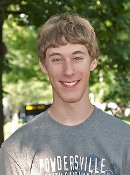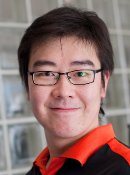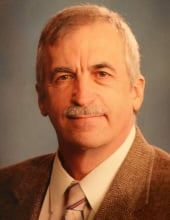
Atmospheric Sciences graduate student Joseph Niehaus is a Fall 2015 recipient of the Dean’s Award for Outstanding Scholarship, as announced by the Graduate School.

Atmospheric Sciences graduate student Joseph Niehaus is a Fall 2015 recipient of the Dean’s Award for Outstanding Scholarship, as announced by the Graduate School.

Engineering Physics graduate student Ran Duan is a Fall 2015 recipient of the Dean’s Award for Outstanding Scholarship, as announced by the Graduate School.

Physics graduate student Hao Zhou is a Fall 2015 recipient of the Dean’s Award for Outstanding Scholarship, as announced by the Graduate School.

David H. Cook of Escanaba, MI, passed away on February 14, 2106, in Houghton, MI, at the age of 72.
Dave cut an unforgettable figure as the Master Machinist in the Department of Physics at Michigan Tech from 1995 to 2005. Here was a man both amiable and always open to new ideas! Some of his more notorious adventures included building a potato gun in accordance with the design by the freshman physics students. This gun was used in class to shoot potatoes across the Portage Canal to learn about propulsion and trajectories. His pencil gun, which he designed and built, used a pencil as a bullet and was able to penetrate a block of wood several inches deep. This gun was used in classes to demonstrate energy and momentum transfer. He was well-known for keeping a “pet mongoose” in his lab, which he often used to test the fear factor of faculty, students and staff. In addition to designing and building scientific instruments, his duties also included research engineering, mechanical design, chemical hygiene and safety. Many remarked that he had the ability to turn a subject as dry as safety into something fun and enjoyable.
Dave actively participated in multiple high profile research and educational outreach projects. He was deeply involved in “The Night Sky Live Project,” the objective of which was to search the night sky for comets, meteors, stars, and supernovas. The “Rockets for Schools” program, which was immensely popular among high school students, became a reality largely due to his efforts.
In the department, Dave was one of the greatest advocates for graduate students. Faculty and students would bring him their ideas. Dave understood that the experimental nature of their work might require 25 tries to turn that idea into something precise and functional. He was gifted in his ability to create experimental apparatuses that were so refined and essential that, while students may not always remember all the interesting information told to them by their professors, they were likely to remember the instruments that Dave designed and built. Furthermore, even students who studied theoretical or computational physics for their graduate degrees wanted to take his course on the manufacture of precision instruments.
Dave’s interest in others, his warmth, patience, and sense of humor made him very approachable to the extent that many students sought his advice on home and car repair. He was not only their instructor and machinist, he was also a wonderful, resourceful friend.
Dave was also an outdoorsperson and artisan. He enjoyed hunting, fishing, boating, woodcarving, and gunsmithing. His absence will be felt for many years.
A rich profile and the opportunity to express condolences may be found online.
Cloud formation boosts soot albedo
A team in the US has found that soot becomes more compact under the conditions of cloud formation, scattering more light as it does so.
The compaction, which is greater for icy than supercooled cloud droplets, should be taken into account in future climate models, the researchers say.
“A change in the scattering [resulting from compaction] can have quite a large effect on how much soot would warm the atmosphere,” said Claudio Mazzoleni of Michigan Technological University in the US. “Therefore, knowing how soot compaction might affect the scattering is important to better understand future climate.”
Read more at Environmental Research Web, by Jon Cartwright.
Morphology of diesel soot residuals from supercooled water droplets
and ice crystals: implications for optical properties
doi:10.1088/1748-9326/10/11/114010
The Michigan Tech chapter of the Society of Physics Students (SPS) has been selected as one of the Distinguished SPS Chapters. The chapter here has been named either Outstanding or Distinguished every year since 2009.
The Michigan Tech chapter is part of Zone 09. SPS Chapter Awards are selected by Zone Councilors and Associate Zone Councilors of the SPS National Council. Some of the award criteria include outreach efforts and contributions to student recruitement and retention.
 The following paper from Professor Ravi Pandey’s research group has been selected as one of the most excellent recent papers that report significant advances in 2D materials beyond graphene.
The following paper from Professor Ravi Pandey’s research group has been selected as one of the most excellent recent papers that report significant advances in 2D materials beyond graphene.
Effects of extrinsic point defects in phosphorene: B, C, N, O, and F adatoms
Gaoxue Wang, Ravindra Pandey, Shashi P. Karna
Appl. Phys. Lett. 106, 173104 (2015)
The papers are hand selected by Associate Editor Roger K. Lake of the University of California Riverside and reported in AIP Applied Physics Letters. The selected articles are free to read for a limited time.

David James Lucas, loving husband, father, brother, and friend passed away Wednesday, December 16, 2015.
Dave was born August 23, 1953 in Ironwood, Michigan to the late John and Alice (Cirolini) Lucas. He married Marsha (Erickson) Lucas on June 2, 1979 in Ironwood, Michigan. Dave graduated from Luther L. Wright High School in 1971. After obtaining his Associates degree from Gogebic Community College in 1973 he completed his Bachelors degree from Michigan State University in 1975.
He earned his Master’s degree at Michigan Technological University in 1977. Dave began his professional career at Eastman Kodak in Rochester, New York before returning to MTU where in 1986, he was the very first person to earn a PhD in Physics.
He took a position in the Physics Department at Northern Michigan University, becoming tenured and promoted to associate professor in 1991. During sabbatical at Argon National Laboratories, in 1992-1993, Dave was able to research and co-author a paper with a Nobel Prize winning physicist. After returning to NMU, he became full-professor in 1997, Pre-Medical/Pre-Health Professional Advisor in 1998 and head of the Physics Department in 2001 where he touched the lives of countless students while guiding their career paths. He was named a Northern Michigan University Distinguished faculty member in 2006 and an “Outstanding Alumni” from Gogebic Community College in 2013.
At a keynote address Tuesday during the American Geophysical Union Fall Meeting in San Francisco, Peter Diamandis, chairman and CEO of XPRIZE, announced the launch of the $7M Shell Ocean Discovery XPRIZE, a three-year global competition challenging teams to advance ocean technologies for rapid and unmanned ocean exploration.
As part of the total $7M prize, the National Oceanic and Atmospheric Administration is offering a million dollar bonus prize to teams that demonstrate their technology can “sniff out” a specified object in the ocean through biological and chemical signals. David Schewitz, Shell vice president of geophysics for the Americas, and Richard Spinrad, chief scientist at NOAA, joined Diamandis on stage to launch the new competition.
David Ciochetto, research engineer in Michigan Tech’s Physics Department feels the competition could be of special interest to the Great Lakes Research Center community and to those in Mechanical Engineering and Electrical Engineering working on underwater robotics.